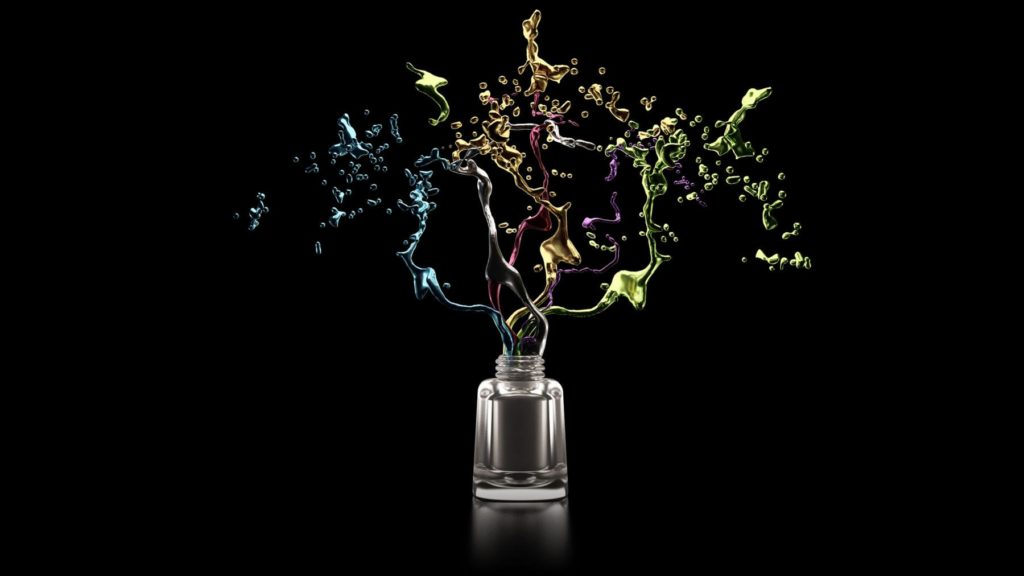For many woman—and men—painting their nails provides a means for expressing themselves. The expanding choices of today allow them the ever-widening opportunity to make unique statements. Thermochromic, photochromic, magnetic, and textured nail polishes are just a few of the products currently on the market. In some cases, users have the option of buying a finished product or purchasing the novel ingredients and creating their own polishes.
Thermochromic and photochromic nail polishes change color with changes in temperature or exposure to UV and/or visible light, respectively. Leuco dyes and liquid crystals are the key ingredients in thermochromic products. These dyes are encapsulated with a solvent and organic acid. At lower temperatures the solvent is solid and holds the dye and acid in close contact, resulting in a structure that interacts with visible light. At temperatures above the melting point of the solvent, it is in a liquid state, and the acid and dye are no longer in sufficient proximity, leading to a loss of color. Similarly, thermochromic liquid crystals (TLCs) are also often encapsulated to protect them from reaction with other ingredients in the nail polish. The color of TLCs changes as the crystalline state changes with temperature—at lower temperatures the crystals are tightly packed, while at warmer temperatures (the “liquid” state) they are loosely organized. Some thermochromic polishes change from clear to colored, while others change from one color to another as the finger temperature changes. The effect can be quite interesting, as often the temperature of the fingers is not constant across the entire fingertip.
Photochromic nail polishes contain ingredients that interact with light, undergoing a structural change. Typically this change involves the reversible formation of conjugated bonds. When no conjugation is present, the compounds are translucent. Once they interact with ultraviolet light, however, a highly conjugated structure is formed that interacts with visible light.
Magnetic nail polish contains small particles whose movement is influenced when exposed to a magnetic field. The nail polish is supplied with different types of magnets that are used to move the particles in the wet-applied polish to generate distinct patterns.
Textured nail polishes contain a variety of ingredients that impart many different appearances. Silica is used to create satin or matte finishes, while polyethylene fibers add a three-dimensional look. Other popular looks include “fuzzy”, velvety, and granular. Incorporation of glass or plastic microbeads leads to a “caviar” appearance. A very different effect can be created by adding a more rapid-drying solvent to typical nail polish formulations. Because the areas containing the ethanol dry more rapidly, there are differences in the viscosity and surface tension of the polish, leading to the formation of cracks, the thickness of which depends on the thickness of the coat.
Finally, it is worth mentioning nail polish strips, which allow users to avoid the need to apply liquid nail polish. These strips consist of one or more layers of nail polish applied to adhesive layers with removable backing that are die-cut in a fingernail shape. They can mimic common looks such as a French manicure or include highly complex patterns and decorations (glitter and metallic effects). The strips are typically composed of high molecular weight nitrocellulose that is flexible and stretchy. Some, however, are fully UV curable, including the adhesive and the decorative strip.
If that’s not a sufficient selection, you can try glitter, holographic, pearlescent, chrome, and many other looks for your nails.
For more information on these and other technologies used in creative nail polishes, see F. C. Pagano, “Technology-driven Trends in Nail Polish Color and Texture,” Cosmetics & Toiletries, January 14, 2014. https://www.cosmeticsandtoiletries.com/formulating/category/color/premiumTechnology-driven-Trends-in-Nail-Polish-Color-and-Texture-239975931.html#sthash.pY4haHi0.dpuf.
